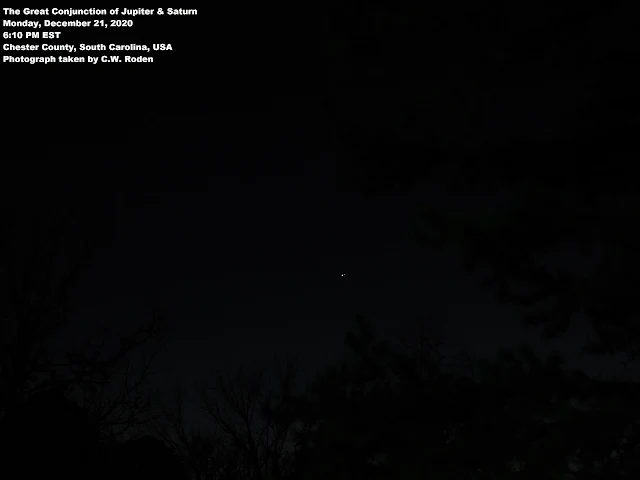Good Evening and Happy Holidays, Y'all!
Today, December 21st, marks the winter solstice for 2020. The winter solstice marks both the shortest day of the year, as well as the longest night of the year -- the astrological tipping point of the Earth's axis where daylight once again starts gaining ground on darkness in the Northern Hemisphere.
This detail is quite symbolic with my night sky planetary photography offering for y'all this evening. A sight that has not been witnessed here on Earth since the European Middle Ages, and is believed to have been a scene witnessed earlier to one of the greatest moments in human history -- the birth of Jesus Christ.
This evening, my corner of South Carolina was truly blessed with clear skies for a perfect view of the Great "Christmas Star" Conjunction of the giant planets Jupiter and Saturn. My first photo was taken 45 to 50 minutes after sunset.
As y'all can see Jupiter and Saturn are so close together they almost appear to be a single bright star to the naked eye. With my camera's lens, however, you can clearly see Jupiter and Saturn together at less than 0.1 degree apart side by side -- which about the thickness of a dime held at arm's length,
according to NASA -- making them appear to be a double planet.
The word conjunction is used by astronomers to describe meetings of planets and other objects on our sky’s dome. The term great conjunction is used to describe the meeting between the two largest heavenly bodies in our solar system, which happen about every 20 years, or so, when the two outer planets appear close in our night sky from Earth. The last of these took place in the year 2000.
Though the two planets appear
spectacularly close together from our perspective here on Earth right now, Jupiter and Saturn
are actually a whopping 456 million miles apart from one another, even at this close approach in their planetary orbits. Saturn is
nearly twice as far away from us as Jupiter and appears much smaller, in spite of its famous rings. Saturn takes nearly 30 years to go around the sun, while Jupiter takes
nearly 12 years. Thus, every 20 years, Jupiter catches up to Saturn as
viewed from Earth.
However, what makes the 2020 great conjunction of Jupiter and Saturn so special is the fact that its the closest one since Wednesday, July 16, 1623 when they were only 5 arc minutes apart. This took place roughly 13 years after the Italian astronomer Galileo Galilei invented the first telescope!
Before this an even closer recorded Great Conjunction of Jupiter and Saturn occurred in the early morning hours of Saturday, March 4, 1226 during the Middle Ages. Tonight's conjunction is the closest meeting of the two planets in Earth's sky dome since that time, with the next really close great conjunction not happening again until the two gas giants stage another exceptionally close show
just 60 years from now, in March 2080.
What makes this astronomical event so important is the speculation by some scientists that it was a great conjunction of the two giant planets and the bright star Regulus which occurred in the year 2 BC -- the same year as the estimated birth of this historic Jesus Christ in Bethlehem recorded in the book of Matthew in the Bible.
This great conjunction of the two planets
and Regulus are believed to be the possible event that formed the Star of Bethlehem (or Christmas Star) that the Three Wise Men
(Magi) in the biblical Nativity story were thought to have seen that
inspired them to travel to Judea (modern-day Israel) to find the newborn Jesus.
This is, of course, one of several probable theories regarding the Star of Bethlehem. All the same, considering this year's close great conjunction corresponding with the winter solstice and the beginning of return of longer days, or "light conquering the darkness" if you will, and the symbolism could not be any closer from an astrological and theological point of view.
That's pretty awesome, huh?
My next photo is a close-up of the great conjunction and shows something really cool -- an elongated Saturn from its famous rings, and the four Jovian, or Galilean Moons: Io, Ganymede, Europa, and Callisto.
In 1610, 14 years before the great conjunction of 1623, Italian astronomer Galileo pointed his newly improved telescope to the night sky, discovering the four largest moons of Jupiter. In that same year, Galileo also discovered a strange oval surrounding Saturn, which later observations determined to be its rings.
Note the oval shape of Saturn in my photo, taken from my trusty Sony DSC-H300 digital camera with 35X Optical Zoom lens at full magnification. It and the large Jovian Moons all appear in my photo probably about the way Galileo first witnessed them when he made his discoveries.
Finally, my last photo of the evening is a beautiful close up of the last First Quarter Moon of the year 2020 during the solstice.
Well folks, I certainly hope y'all enjoyed me photos of this once-in-a-lifetime event as much as I enjoy bringing them to all of y'all. Truly a beautiful astronomical event and one for the ages. Please let me know what you think in the comments section below, and as always have a good evening....and Merry Christmas to y'all!




2 comments:
Such a great post! Thank you so much for sharing this post!
I read the entire post and it is really precious blog for me. Thank you for outstanding post :)
Post a Comment